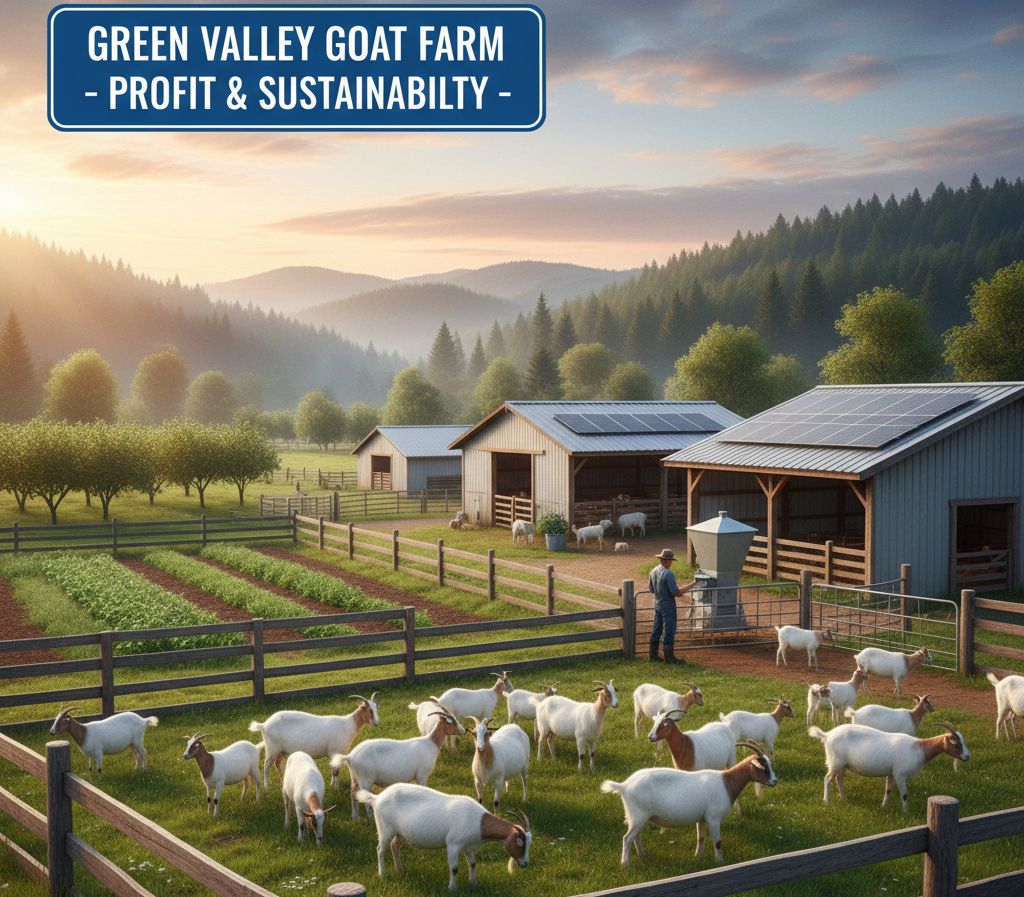Table of Contents
Introduction
Agriculture goat farming is quickly becoming one of the most profitable and sustainable ventures in modern livestock production. With global demand for goat milk, meat, and fiber steadily rising, farmers are realizing that this small yet resilient animal offers big rewards. Goat farming combines traditional agricultural wisdom with innovative practices that ensure both economic and environmental benefits. Whether you’re an aspiring farmer or a seasoned agricultural entrepreneur, understanding how to establish and manage a productive goat farm can be the foundation for lasting success.
1. Understanding the Basics of Goat Farming
Goats have been domesticated for thousands of years and serve as a vital source of milk, meat, and fiber in many parts of the world. Unlike cattle, goats are hardy animals that thrive in diverse climates, from arid deserts to lush pastures. Their ability to adapt makes them ideal for small-scale farmers as well as commercial producers.
Successful Agriculture Goat Farming starts with understanding key principles such as breed selection, proper housing, feeding, and disease prevention. A well-planned goat farming system minimizes risks while maximizing yield and profit.
2. Choosing the Right Goat Breed
Selecting the right breed is one of the most critical steps in agriculture goat farming. Different breeds serve different purposes—some excel in milk production, while others are better for meat or fiber.
- Dairy Breeds: Saanen, Alpine, and Toggenburg are popular for their high milk yield.
- Meat Breeds: Boer and Kalahari Red goats are favored for their rapid growth and meat quality.
- Fiber Breeds: Angora and Cashmere goats produce valuable wool that fetches premium prices in textile markets.
When choosing a breed, consider local climate conditions, available feed, and your specific production goals.
3. Setting Up a Profitable Goat Farm

To establish a successful agriculture goat farming business, start with a solid plan. Here are essential steps:
- Land and Shelter: Goats require clean, dry, and well-ventilated housing. Each adult goat should have at least 1.5 to 2 square meters of space.
- Fencing: Secure fencing is necessary to protect goats from predators and prevent them from wandering.
- Water and Feed Supply: Ensure a constant supply of clean water and access to quality forage. Supplement their diet with minerals and vitamins.
- Record Keeping: Track breeding cycles, vaccinations, and milk or meat yield to improve management efficiency.
A structured approach to farm setup ensures steady growth and long-term profitability.
4. Feeding and Nutrition Management
Balanced nutrition is vital for maintaining healthy goats and high productivity. Goats are natural browsers, preferring to eat leaves, shrubs, and herbs rather than grass. However, managed feeding ensures consistent nutrient intake.
A typical goat diet should include:
- Green Fodder: Lucerne, cowpea, and Napier grass.
- Dry Fodder: Hay or crop residues like maize stalks.
- Concentrates: Grains and protein supplements during lactation or pregnancy.
- Mineral Mixtures: Provide salt licks or mineral blocks for essential nutrients.
Proper nutrition enhances milk yield, fertility, and disease resistance.
5. Breeding and Reproduction Techniques
Effective breeding management determines the overall success of your agriculture goat farming venture. Female goats (does) typically reach maturity between 7–10 months, depending on the breed. Mating should occur when they are healthy and have reached optimal weight.
Common breeding methods include:
- Natural Breeding: Allowing bucks and does to mate naturally within the herd.
- Controlled Breeding: Selecting specific breeding pairs to improve genetic quality.
- Artificial Insemination (AI): Used for genetic improvement and disease control in large farms.
Maintaining accurate breeding records helps optimize kidding intervals and enhances productivity.
6. Goat Health and Disease Management
Healthy goats are the foundation of profitable agriculture goat farming. Diseases can spread rapidly within a herd if not managed properly. Preventive healthcare, vaccination, and regular checkups are essential.
Common goat diseases include:
- Peste des petits ruminants (PPR)
- Foot-and-mouth disease (FMD)
- Internal and external parasites
Preventive Measures:
- Maintain hygiene in goat sheds.
- Deworm goats regularly.
- Follow a vaccination schedule advised by a veterinary professional.
Quick response to illness reduces losses and improves herd survival rates.
7. Marketing and Profit Strategies
Once your goats are healthy and productive, the next challenge is marketing your products. Agriculture Goat Farming offers multiple revenue streams:
- Meat Production: Goat meat is lean, nutritious, and has a global market.
- Milk and Cheese: Goat milk is rich in nutrients and used to make specialty dairy products.
- Fiber and Leather: Angora and Cashmere goats produce premium-quality wool and hides.
- Manure: Goat droppings are excellent organic fertilizer for crops.
Marketing Tips:
- Build relationships with local butchers, dairy processors, and textile producers.
- Use social media and local markets to reach consumers directly.
- Consider organic or sustainable branding to attract eco-conscious buyers.
Smart marketing turns small-scale operations into profitable agribusiness ventures.
8. Sustainable Goat Farming Practices
Modern agriculture emphasizes sustainability, and agriculture goat farming aligns perfectly with this goal. Goats require less feed and space than other livestock, and their manure enriches the soil naturally. Integrating goat farming with crop cultivation creates a circular system where both complement each other.
Eco-friendly practices include:
- Rotational grazing to prevent overgrazing
- Organic feed production
- Waste recycling for biogas or compost
Adopting sustainable methods not only benefits the environment but also enhances brand value and long-term profitability.
9. Challenges in Agriculture Goat Farming

Despite its potential, agriculture goat farming has challenges that farmers must manage effectively:
- Limited veterinary support in rural areas
- Market price fluctuations
- Feed shortages during dry seasons
- Lack of awareness about modern farming techniques
However, these challenges can be overcome through training, government support programs, and technology-driven farm management systems.
10. Future of Goat Farming in Agriculture
The future of agriculture goat farming looks promising with innovations like digital monitoring, AI-based health tracking, and automated feeding systems. As global demand for sustainable meat and dairy increases, goat farming is poised to play a major role in meeting food security goals.
Moreover, government initiatives promoting small-scale livestock enterprises make this sector an attractive investment opportunity for new farmers and entrepreneurs alike.
Conclusion
Agriculture goat farming offers unmatched potential for profitability, sustainability, and food production. With minimal investment and careful management, anyone can transform this age-old practice into a modern agribusiness. From choosing the right breed to marketing products, each step contributes to long-term success. By embracing sustainable methods and continuous learning, today’s farmers can ensure that goat farming remains one of the most valuable assets in global agriculture.
FAQs
1. Is goat farming profitable?
Yes. With proper breed selection, feeding, and management, goat farming can yield excellent returns, especially in meat and dairy production.
2. How much land is required for goat farming?
A small-scale farm with 50 goats can operate effectively on 1–1.5 acres, including grazing and housing areas.
3. What is the lifespan of a goat?
Goats live for 10–12 years, but their most productive years are typically between ages 2 and 7.
4. Which breed is best for beginners?
Boer and Saanen breeds are popular for beginners due to their adaptability and productivity.
5. How do I market goat products?
Use a combination of local markets, social media platforms, and direct partnerships with processors or restaurants to sell meat, milk, and fiber products.



